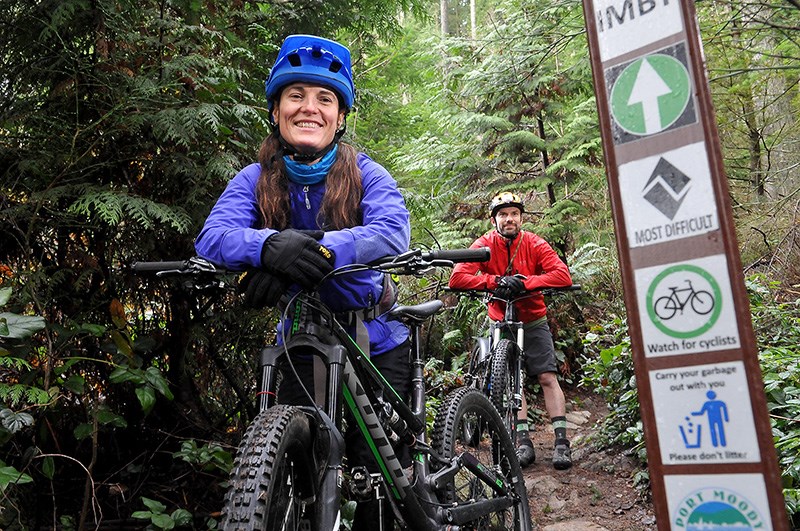An agreement between the Tri-Cities Off-Road Cycling Association (TORCA), land managers, user groups and various levels of government could blaze a trail to turning Eagle Mountain into a world-class destination for mountain bikers.
Karaleen Gioia, the president of TORCA, said the agreement is the culmination of a five-year process to legitimize mountain bikers on the mountain’s network of about 40 kilometres of accessible trails that snake through the woods from Coquitlam to Port Moody. It also means the group will be able to pursue various sources of funding to help maintain existing trails, build new ones, as well as erect proper signage to guide visitors around the mountain.
Gioia said until now, bikers have been riding the mountain with an air of uncertainty: trails could be shut down without notice as occured on parts of Mount Seymour in North Vancouver last year; construction and maintenance of trails had to be organized on the down-low. But now the 200 or so members of her group will be able to work with other users like running clubs, dog walkers and 4X4ers to develop and promote Eagle Mountain’s recreational assets. It will also help the mountain.
“An unmanaged forest isn’t good for users or the environment,” Gioia said, adding the agreement will bring a level of sustainability and environmental protection to the mountain by decommissioning trails prone to erosion and allowing for better maintenance to ensure existing trails don’t deteriorate or impact the watershed.
Gioia said protecting Eagle Mountain’s position in the Coquitlam watershed was especially critical. That meant extensive consultations with the fish hatcheries at Noon’s, Mossom and Hoy creeks to ensure recreational use doesn’t have a negative effect on their ongoing efforts to protect their streams and populate them with fish. TORCA also had to bring on board the cities of Port Moody and Coquitlam, the village of Anmore, as well as the provincial government — through Rec Sites and Trails B.C. Fortis and BC Hydro were also involved.
Gathering all those disparate interests at the table took a lot of time, energy and paperwork, including surveys and producing maps of the mountain and its trails.
“We had to identify valued trails and what we could tackle.” Gioia said.
That involved hiking all the mountain’s trails eight to 10 times with representatives of the various user groups, taking notes and photos along the way. The group also had to address safety and liability concerns, which led to the dismantling of aging and unauthorized features like log rides and stunts on some trails that caused a level consternation in the mountain biking community last summer.
Gioia said the image of mountain biking has changed over the years. They’re no longer the armoured adrenaline-charged thrill seekers thrashing through the woods on 40-pound behemoth bikes to fly off ever-dangerous ramps and balance along precarious rails.
“It’s now a sport that appeals to all ages,” she said.
That’s why it was important TORCA get in front of conflict issues on Eagle Mountain, said its vice president, Steve Sheldon.
“You don’t want to be a reactive club.”
Sheldon said as other mountain bike groups confront the issues on their mountains, they’re better positioned to share information and experiences with each other that will make the sport more accepted and accessible everywhere. And that can lead to greater opportunties to attract riders from other parts of the world.
“It’s become a big community,” he said.
Gioia said mountain bikers on Eagle Mountain have so far led a pretty peaceful coexistence even as many of the trails skirt residential areas creeping up the slopes. Some of the residents in those houses are TORCA members and people moving into the area are often attracted by the proximity to the mountain’s trails.
Still, educating riders to be respectful of their environs is an ongoing process, Gioia said. Now they’ll be able to do it out in the open, with the potential to harness Eagle Mountain’s full recreational assets.
“We’re just at the start of this process,” she said. “It’s exciting to see what the future holds.”



